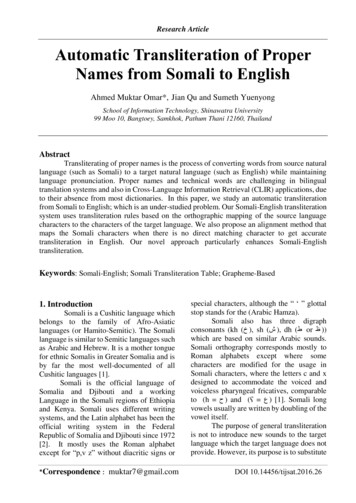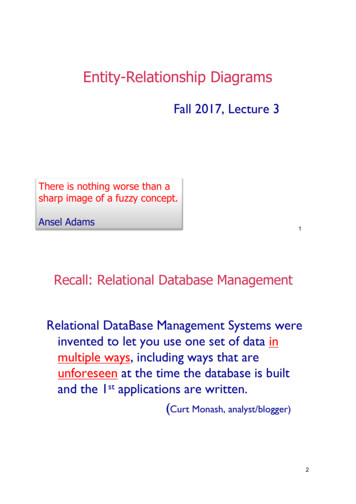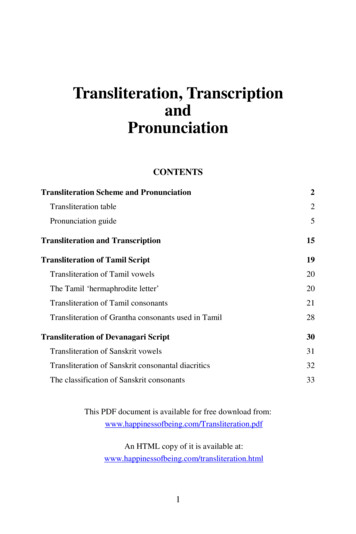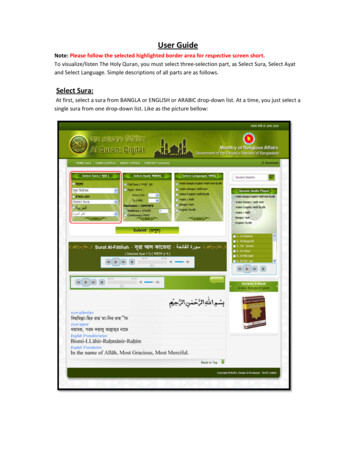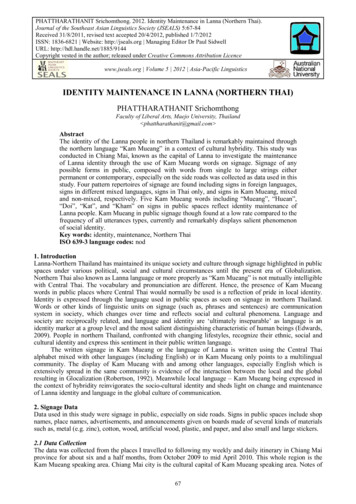
Transcription
ISBN: 978-981-18-1791-52021 the 11th International Workshop on Computer Science and Engineering (WCSE 2021)doi: 10.18178/wcse.2021.02.012Neural Named Entity Transliteration for Myanmar to EnglishLanguage PairAye Myat Mon 1 , Khin Mar Soe 21, 2Natural Language Processing Lab., University of Computer Studies, Yangon, MyanmarAbstract. Named entity (NE) transliteration is mainly a phonetically based transcription of names acrosslanguages using different writing systems. This is a crucial task for various downstream natural languageprocessing applications, such as information retrieval, machine translation, automatic speech recognition andso on. Robust transliteration of named entities is still a challenging task for Myanmar language because of thecomplex writing system and the lack of data. In this paper, we proposed our Myanmar-English named entityterminology dictionary and experimented on transformer-based neural network model. Furthermore, weevaluated the performance of neural network-based approach on the transliteration tasks using BLEU score.Different units in the Myanmar script, i.e., character units, sub-syllable units and syllables units are comparedin the experiments.Keywords: myanmar language, transformer, neural network, named entity, transliteration1. IntroductionAccording to the linguistic point of view, transliteration is the tasks of representing words from sourcelanguage script using the approximate phonetic or spelling equivalents of target language script. Meanwhile,the quality of machine translation has improved significantly but there are still many problems emerging tobe solved to emend machine transliteration. Precise transliteration of named entities plays a very significantrole in improving the quality of machine translation and cross language information retrieval and theirattainment depends extremely on accurate transliteration of named entities.In this study, the tasks of Myanmar named entity Transliteration is indicated from initial rawtransliteration instances collection to manual annotation and final experiments. Like Myanmar, one majorobstacle of low resource languages is the problem of out-of-vocabulary (OOV) words. Thus, our in-houseMyanmar-English bilingual named entity terminology dictionary is contrived to promote Myanmar naturallanguage processing research areas. Our experiments aim to compare Myanmar (My)-English (En)transliteration directions with character units (Char), sub-syllable units (Sub-Syl) and syllable units (Syl) onMyanmar side and standard character units on English side using Openmt open source toolkit for transformermodel. This approach performs well on cross lingual transliteration tasks. To the best of our knowledge, webelieve that our work will be the first attempt in this direction.The paper’s structure is organized as follows. In session 2, we discuss the related work and in session 3,we present the nature and collation of Myanmar language. The issues of transliteration and construction ofMy-En terminology dictionary are described in session 4 and 5. We show the experiments in session 6 andconclude the final in session7.2. Related WorkAlthough prior research made to improve the transliteration process based on many languages such asEnglish, Chinese, Korean, Japan and Thailand etc., it still need to accomplish for Myanmar language due tolack of efficient resources. According to surveys, there are a few researches for Myanmar Language.Transliteration process is similar to Romanization or Transcription process for rendering Myanmar Latin Corresponding author. Tel.: 95-9-750989163; fax: 95-1-610633.E-mail address: ayemyatmon.ptn@ucsy.edu.mm.70
alphabet which can cast as a clarified translation process on grapheme level or phrase level withoutreordering the operations.In prior work [1], the authors performed Myanmar Name Romanization task by using sub-syllable andsyllable units based on small amount of training data. Although the system gets the efficient results instatistical way, it still has some necessities because LSTM network require more training data. In theproposed system, we have prepared enough training data to apply neural network approaches by tuning thedifferent hyper parameters to improve the performance of transliteration task. In reference [2], the authorsapplied grapheme to phoneme (G2P) conversion on Myanmar Language. This system is mainly emphasizedfor speech recognition rather than NLP. The transformer model was presented in [3] which rely on only selfattention by avoiding the needs for sequential processing. Unlike the encoder-decoder architecture, there isno information bottleneck in hidden state vectors in transformer model.3. Nature and Collation of Myanmar LanguageThe Myanmar alphabet (မြန်ြာ အက္ခရာ) is an abugida and their original calligraphy was a square formatbut currently changed to rounded format. It is the first language of native Myanmar people and also theofficial language of the Republic of the Union of Myanmar. Basically, the spelling of Myanmar script issyllable-based. One word belongs to multiple syllables and one syllable by multiple characters. In betweenthe characters and symbols, sub-syllable units may be designed for specific task [1]. Figure 1 exposes thesyllable structure defined by Myanmar script. The initial consonant (C) on the left is obliged; morecharacters for consonant clusters, alternated vowels, syllable codas and tones can be added gradually.Fig. 1: The Collation of Myanmar Syllable4. Transliteration IssuesContinuous growth of out of vocabulary names (loan words) to be transliterated, there are no systematicrules in Myanmar language. Myanmar loan word is overwhelmingly in the form of proper nouns (i.e., personnames, place names and organization names). As a natural consequence of British rule in Myanmar, Englishhas been another major source of vocabulary, especially about technology, measurements and moderninstitutions. In major case of Myanmar name transliteration, the adoption of an English word, adapted to theMyanmar phonology, known as direct loan. For example, “Confucius” (Chinese philosopher) is“ကွန်ဖ ြူးရှပ”် and “Sidney” (City in Australia) is “ဆစ်ဒနီ” in Myanmar terms respectively. There are manyissues on transliteration because Myanmar writing and pronunciation have some conflicts between native andforeign words. In some writing script of Myanmar alphabets such as “ဆ”, “စ” and “သ” are pronounced into“Sa”, “S” and “Tha”. The “သ” is not clear today because “သ” is usually pronounced as “Tha”. Even thoughthis pronunciation has been accepted in other nationalities, i.e., other ethnic group like ‘Mon’, “သ” ispronounced as “S”. For instance, other Myanmar vowels like “အ ော”, “ဩ”, “အဩော” and “ဪ”, are writtenas “Aw” which are pronounced as “O”. Anyway, “သီရိ-လင်ကကော” (Democratic Socialist Republic of Sri- Lanka)71
is written as “Sri-Lanka” but pronounced as “Thiri-Linka”. Generally, Transliterating names is an easy wayto pronunciation as much as accurate representation for native speakers, but the above confusions can cause aproblem of spelling difficulty and effect on the accuracy of transliteration tasks.5. Myanmar–English Named Entity Dictionary ConstructionOne of the main reasons is the lack of resources such as annotated-corpus, gazetteers or name-mappingdictionary and name-lists etc. That is to say, Myanmar language is resource-constrained language. As amatter of this fact, My-En bilingual named entity terminology dictionary is proposed to coverage theseproblems.We used University of Computer Studies (UCSY) corpus [4] and Asian Language Treebank (ALT)corpus [4] in constructing Myanmar-English bilingual NE dictionary. All of the sentences in these corporaare normalized and tokenized for both Myanmar and English languages. The UCSY corpus comprises 200KMyanmar-English pairs of parallel sentences which are collected from textbooks and local news articles [5]developed by NLP lab, UCSY, Myanmar. ALT corpus is one of the segments of ALT project launched byASEAN IVO. It is composed of 20K Myanmar-English pairs of parallel sentences from Wikipedia news.In construction the dictionary, we utilized GIZA open source toolkit [6] to get the raw alignment forsource and target language. To filter the transliteration sentence pairs, we have manually annotated thetransliteration Myanmar term of public figures, places, well-known person and organizations for eachEnglish named entity in this aligned coarse sentence pairs.We performed the experiments based on bilingual dataset which contains 84,057 named entity instancepairs. We first divided these instance pairs into two types: parallel data and monolingual data. We thensubdivided these data into three parts for training, development and testing purpose. The 1K of dataset ismade as testing, 1K as development whiles the rest of the dataset as training. All of the collected namedentities are standardized with Unicode format.DataTrainDevTestTable 1: Data statistics on Train, Dev and TestMyEn# Char# Sub-Syl# Syl# 7610,31413,60416,28814,22111,20114,2536. Experiments6.1. Data PreprocessingMyanmar is a complicated language. So, it needs to be precise data pre-processing. For all experiments,we performed both My En and En My directional sub-tasks on character, sub-syllable and syllable unitsfor Myanmar side and typically smallest character units for English side. The statistical data are mentioned inthe previous NE dictionary construction section.Finally, we implemented our home-made character unit segmenter to segment character and sub-syllableunit segmenter developed by [1], to segment sub-syllable units respectively. We also used syllable segmenter[7] using regular expression for syllable segmentation scheme. All names are lowercased for both languages,and characters separated by space. The Moses script [8] clean-n-corpus.perl is only applied on preprocessedMy-En monolingual data to remove lines containing more than 80 tokens. We described the sample dataformat for My-En NE instance pair for person names in Table 2.UnitCharSub-SylSylTable 2: Sample data format for My En (NE) tasksMy ENbarackhusseinobama ဘ ာ ရ က္ ် ဟ ူ စ ိ န ် အ ိ ု ဘ ာ း ြ ာ း ဘ ာ ရ က္် ဟ ူ စ ိန် အ ို ဘ ား ြ ား barackhusseinobama ဘာ ရက္် ဟူ စိန် အိ ု ဘား ြား barackhusseinobama72
6.2. Experimental SettingTo build contemporary NMT systems, we choose to rely on the transformer neural network architecture[3] since it has been substantiated to outperform in quality and efficiency, the two other mainstreamarchitectures for NMT known as deep recurrent neural network (deep RNN) and convolutional neuralnetwork (CNN).As the original paper indicated [3], Transformer has been used the attention-mechanism we saw earlier.Like LSTM, Transformer is the architecture for transforming one sequence into another one with the help oftwo parts encoder and decoder, but it differs from the conventional existing sequence to sequence modelsbecause it does not imply any recurrent networks (GRU, LSTM, etc.). Additionally, because there is nolonger a sequential recurrent network, model training can be better parallelized, minimizing model trainingtime. To train for Transformer model, we exert on Opennmt toolkit that are publicly released by [9]. All ourTransformer system was consistently trained with the following hyper-parameters on Opennmt except tochanging for layers of network and heads. Model hyper-parameter settings are described as the followingTable 3.Table 3: Hyper-parameter setting for TransformerParametersSettinglayersrnn sizeword vec sizetransformer ffheadsencoder typedecoder typeposition encodingtrain stepsmax generator batchesdropoutbatch sizebatch typenormalizationaccum countoptimadam beta2decay methodwarmup stepslearning ratemax grad normparam initparam init glorotlabel smoothingvalid stepssave checkpoint stepsworld sizegpu 010000106.3. Experimental ResultsThe BLEU score [10] on the character level, sub-syllable level and syllable level was used in theevaluation. The experimental results for En My transliteration in addition to the reversed My-to-Entranscription are expressed in Table 4. For the Transformer model, different combinations of layers (L) andheads (H) were compared in the experiments.Table 4: Experimental Results for My-En (NE) TransliterationsMy EnCharSub-SylSylCharOpen NMT/Transformer (L6,H8)0.920.920.920.75Open NMT/Transformer (L2,H2)0.890.920.920.85Open NMT/Transformer (L4,H4)0.910.920.910.86Open NMT/Transformer (L2,H8)0.920.930.930.86Open NMT/Transformer (L4,H8)0.910.920.920.87System73En 86
By analysing the performance of linguistic feature for My En task, sub-syllable units and syllable unitsperform well to transcribe names than character units on Transformer (L2, H8). The syllable structures haveclearer and play an important role in Myanmar NLP pre-processing tasks. Likewise, sub-syllable units arealso flexible and precise units for statistical approaches and depend on an insightful consideration ofMyanmar phonology. Transformer (L4, H8) also achieves the impressive results upon character units butdramatically falloff the BLEU points on reverse direction.7. Conclusion and Future WorksIn this paper, we introduce our in-house Myanmar named entity (NE) terminology dictionary and addressthe case of (NE) transliteration between Myanmar and English with a systematic comparison of characterunits, sub-syllable units and syllable units using neural based approach; transformer model on our preparedsegmented data. Although, our NE corpus is not so big, neural network models produce satisfied results fortransliteration tasks, we still believe with more data and more experiments, neural network transliterationmodels will have a bright future in this field. This work can be further developed in various directions.Anyway, this exploration of using neural networks for Myanmar NE transliteration is the first work onMyanmar language.8. References[1] Ding, C., Pa, W. P., Utiyama, M., & Sumita, E. (2017, August). Burmese (Myanmar) name romanization: A subsyllabic segmentation scheme for statistical solutions. In International Conference of the Pacific Association forComputational Linguistics (pp. 191-202). Springer, Singapore.[2] Thu, Y. K., Pa, W. P., Sagisaka, Y., & Iwahashi, N. (2016, December). Comparison of grapheme-to-phonemeconversion methods on a myanmar pronunciation dictionary. In Proceedings of the 6th Workshop on South andSoutheast Asian Natural Language Processing (WSSANLP2016) (pp. 11-22).[3] Vaswani, Ashish, Noam Shazeer, Niki Parmar, Jakob Uszkoreit, Llion Jones, Aidan N. Gomez, Łukasz Kaiser,and Illia Polosukhin. "Attention is all you need." In Advances in neural information processing systems, pp. 59986008. 2017.[4] http://lotus.kuee.kyoto-u.ac.jp/WAT/my-en-data/[5] Sin, Y. M. S., Oo, T. M., Mo, H. M., Pa, W. P., Soe, K. M., & Thu, Y. K. (2018). UCSYNLP-Lab MachineTranslation Systems for WAT 2018. In Proceedings of the 32nd Pacific Asia Conference on Language,Information and Computation: 5th Workshop on Asian Translation: 5th Workshop on Asian Translation.[6] Och, F. J., & Ney, H. (2003). A systematic comparison of various statistical alignment models. Computationallinguistics, 29(1), 19-51.[7] https://github.com/ye-kyaw-thu/sylbreak[8] Koehn, P., Och, F. J., and Marcu, D. (2003). Statistical phrase-based translation. In Proc. of NAACL, Vol. 1, pp.48—54.[9] Klein, G., Kim, Y., Deng, Y., Senellart, J., and Rush, A. M. (2017). OpenNMT: Open-source toolkit for neuralmachine translation. arXiv:1701.02810.[10] Papineni, K., Roukos, S., Ward, T., and Zhu, W.-J. (2002). BLEU: A method for automatic evaluation of machinetranslation. In Proc. of ACL, pp. 311—318.74
transliteration Myanmar term of public figures, places, well-known person and organizations for each English named entity in this aligned coarse sentence pairs. We performed the experiments based on bilingual dataset which contains 84,057 named entity instance pairs. We first divided these instance pairs into two types: parallel data and .
